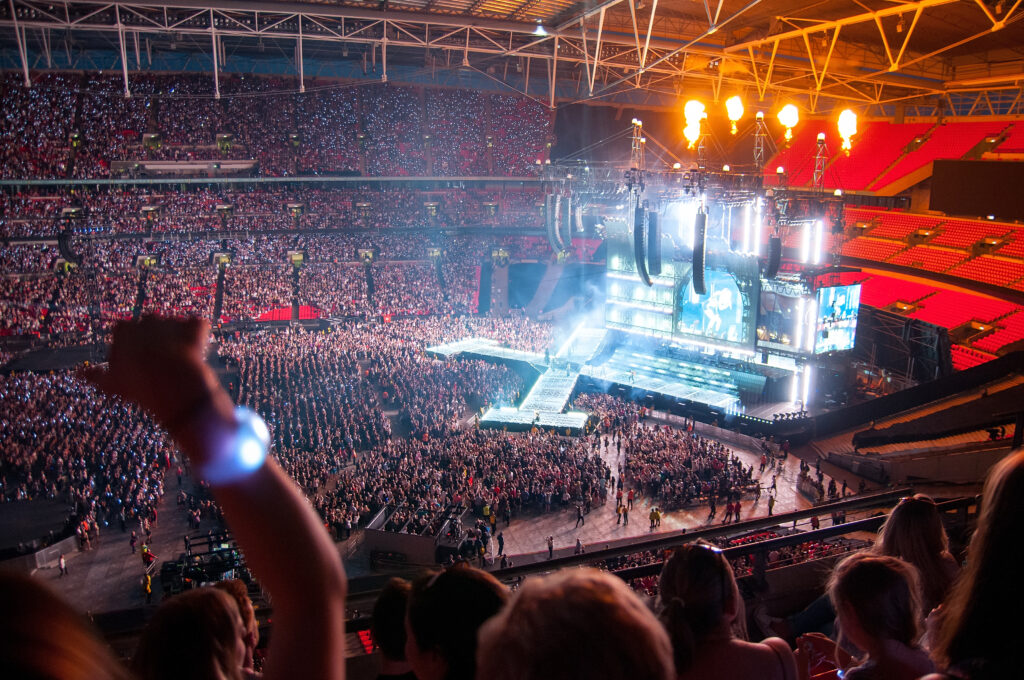
You won’t be surprised to learn 2023 was a record year for concerts in general, and for Live Nation specifically.
Pollstar’s look back at the concert business for last year is filled with nothing but joy…and truckloads of cash. The title of their year-in-review story published this past December says it all:
“The Great Return Becomes Historic Golden Age”
After screeching to a virtual halt during the pandemic, the concert business rebounded to a record year in 2022, only to blow through those numbers last year.
Their data shows a whopping 46% increase from their previously record-setting 2022. In actual dollars, the Worldwide Top 100 Tours grossed $6.28 billion in ’22, guaranteeing virtually everyone in the concert business made their bonuses. And to put a point on it, last year it ballooned to $9.17 billion. The trends in North America were similarly robust.
It had to be like getting a rating book where you’re #1 in every demo. The chart below is mind-boggling, but makes sense to us. After being cooped up for two or so years, consumers were ready to hit the concert scene in ’22 and again, last year:
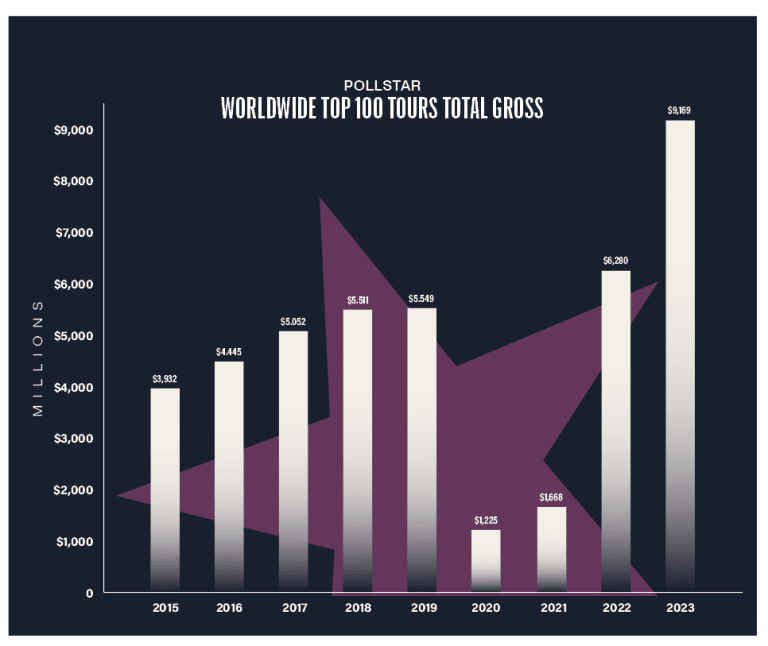
Of course, the confluence of Taylor, Beyoncé, and Bruce (yes, I’m on a first name basis with all three) bolstered last year’s totals. The “Eras Tour” alone generated more than $1 billion – the first time that’s happened.
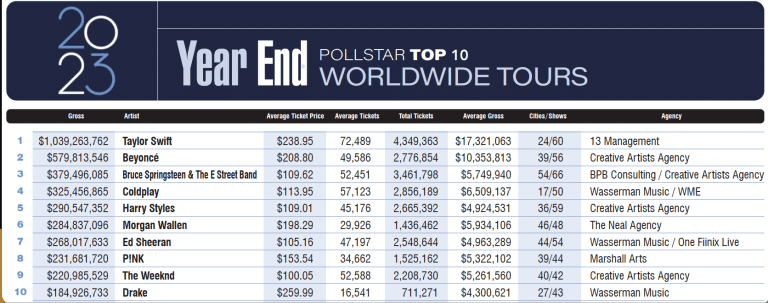
Pollstar notes it’s the first time since 2008 the industry had two women who led the entire pack. That year, Madonna and Celine led the league.
So, what about 2024. While I haven’t seen projections, I have Techsurvey 2024 as my guide. And according to our 31,400+ respondents, core radio listeners are spending gobs of money to satisfy their live music needs.
In fact, among the nearly two-thirds (64%) of TS24 respondents who attended a live music concert, sizable percentages of these active radio listeners ended up spending significant amounts of money on “extras.” Given that these are core radio listeners should capture our strategic attention:
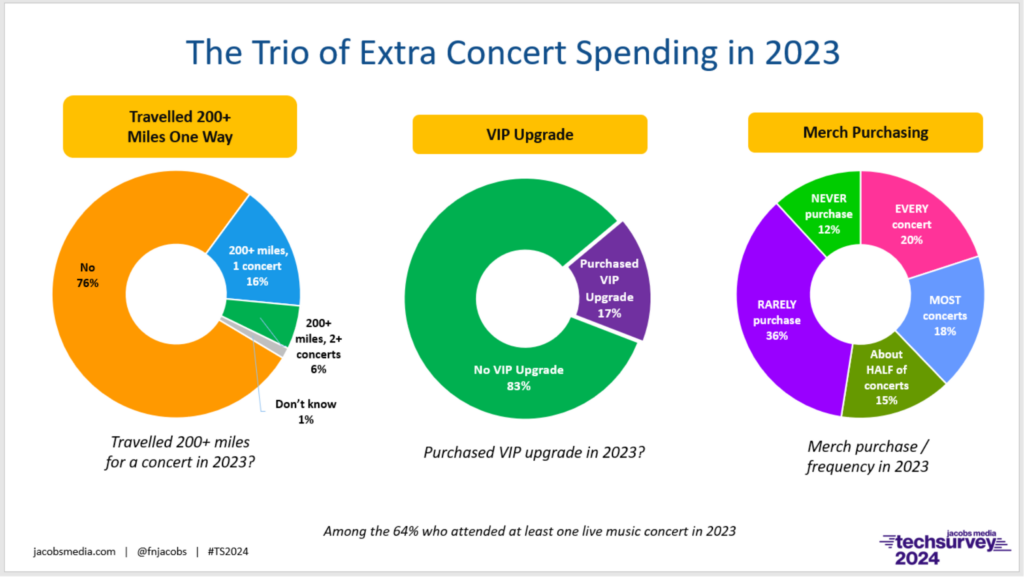
The pie chart on the left reveals the new trend in “going the distance” to see a favorite band. In fact, more than one-fifth (22%) say they journeyed more than 200+ each way to attend a concert last year. Presumably, a number of these mobile concert-goers traveled by plane to take in a favorite artist’s live performance. Is this a new trend in how fans will experience concerts in the coming years? We need to see more data, but my gut response is that long-distance travel for concerts will become the norm for more and more people.
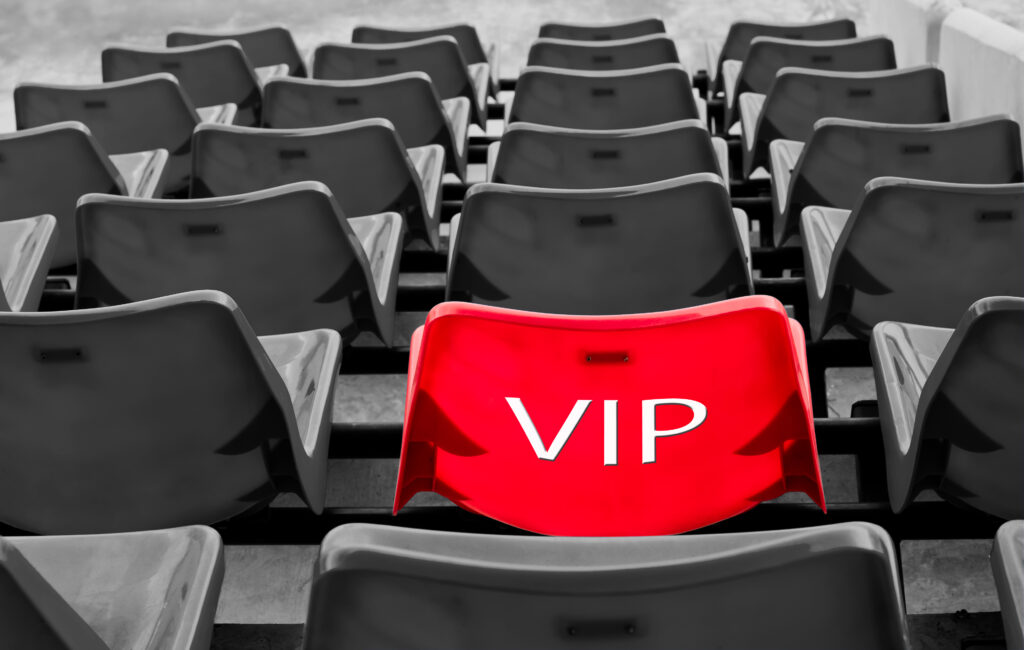 And then there’s the VIP or gold section expenditures represented in the middle pie chart. I was surprised to learn that 17% of 2023 concert goers splurged on the premium access package that may/may not include better seats, meet-and-greets with the band, and other benefits. While the specific benefits vary from band to band, USA Today reports the minimum cost is usually $200 or $300 while the fee can run up into the thousands of dollars depending on the artist and the package. Buying VIP premium tickets from a reseller like StubHub can double or triple these prices.
And then there’s the VIP or gold section expenditures represented in the middle pie chart. I was surprised to learn that 17% of 2023 concert goers splurged on the premium access package that may/may not include better seats, meet-and-greets with the band, and other benefits. While the specific benefits vary from band to band, USA Today reports the minimum cost is usually $200 or $300 while the fee can run up into the thousands of dollars depending on the artist and the package. Buying VIP premium tickets from a reseller like StubHub can double or triple these prices.
And finally, there’s the merch piece. When you consider that nearly four in ten concert-goers 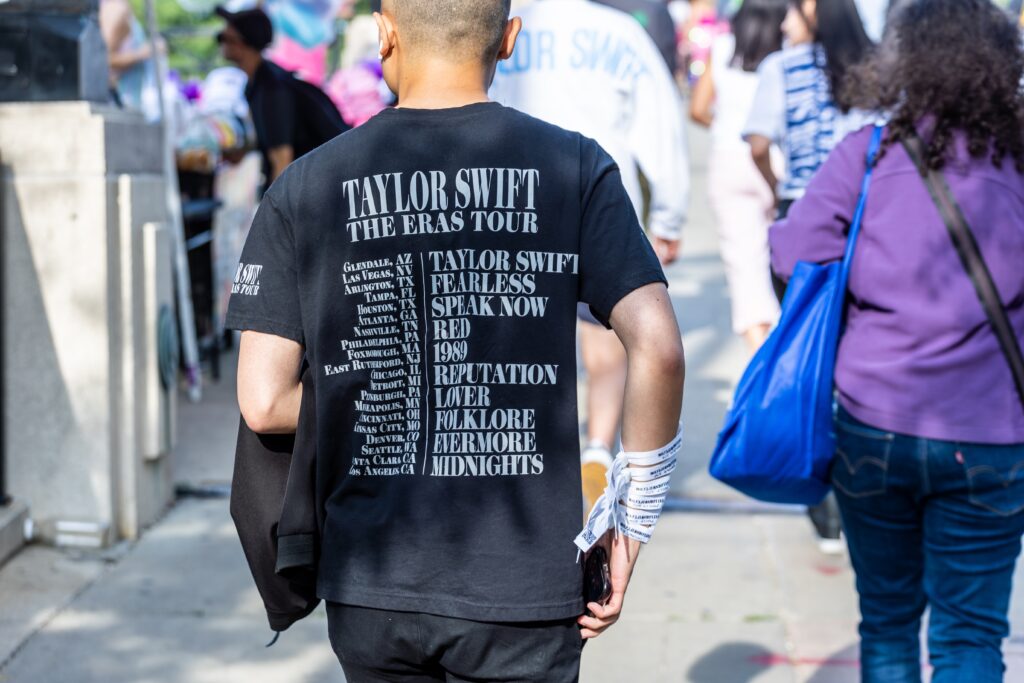 say they purchased artist branded merch for every or most of the shows they attended, we’re talking about incredible extra spending levels. While most people think of Swifties lining up to pay top dollar for merch on her recent tour, the fact is most popular artists do very well on selling their hats, shirts, and other souvenirs that prove they were there.
say they purchased artist branded merch for every or most of the shows they attended, we’re talking about incredible extra spending levels. While most people think of Swifties lining up to pay top dollar for merch on her recent tour, the fact is most popular artists do very well on selling their hats, shirts, and other souvenirs that prove they were there.
These were all new questions in this year’s survey, as I suspected concerts will continue to be an entertainment vertical where people just spend gobs of money. In all three cases above, the younger you are, the more likely you are to part with more cash more often on concert-related extras.
But it goes beyond that. The concert experiences Gen Z’s can now buy may seem like irrational spending, especially to those of us old enough to supposedly know better. But for younger generations swamped with student loan debt, who may never be able to afford to buy a house, and who are delaying starting families, the instant gratification that comes along with going to a concert and splurging on perks provides a level of momentary satisfaction.
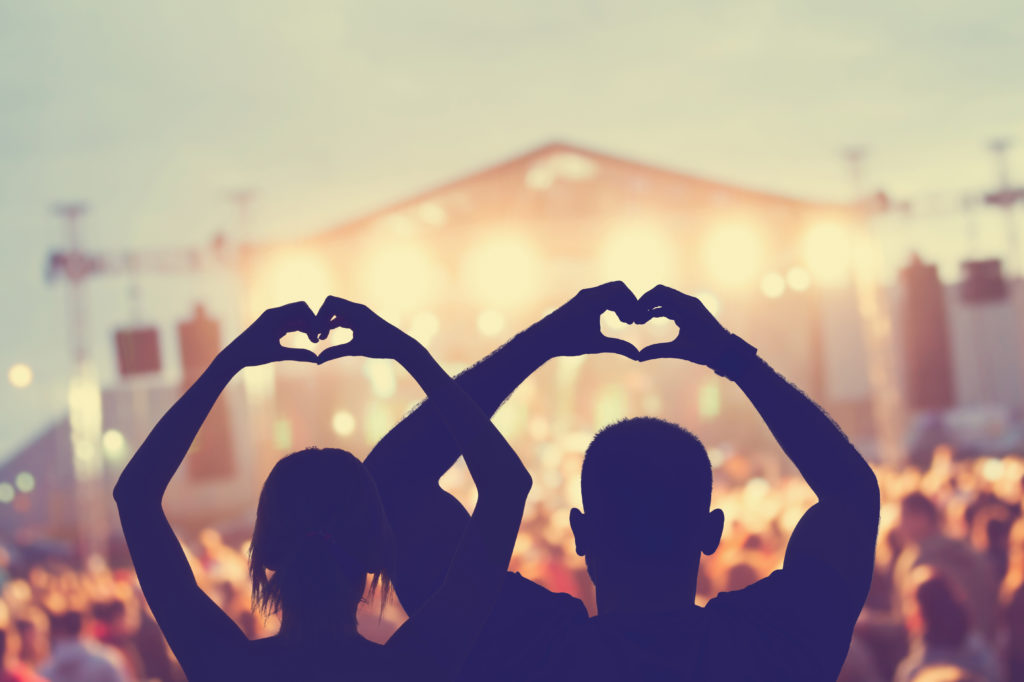 And for radio stations this concert season, it provides an opportunity to craft marketing campaigns and promotions in-step with these growing desires for more immersive experiences. Even those ubiquitous $1,000 group contests could be repackaged to lean into this growing trend, giving listeners the chance to win something they cannot buy – or afford to buy.
And for radio stations this concert season, it provides an opportunity to craft marketing campaigns and promotions in-step with these growing desires for more immersive experiences. Even those ubiquitous $1,000 group contests could be repackaged to lean into this growing trend, giving listeners the chance to win something they cannot buy – or afford to buy.
The COVID boomerang continues to impact all our lives, but especially a radio industry dependent on habit and routine. Consumers may not be going to work at the same time – or going to work period. But their collective desire to enjoy a night of amazing live music experiences has intensified in recent years, something any station can tap into, even with modest or no marketing budgets.
Embracing concerts and experiencing the joy your fans feel when a popular band or music performer comes to town is another way to connect and relate with an audience looking for fun experiences.
One postscript: merch
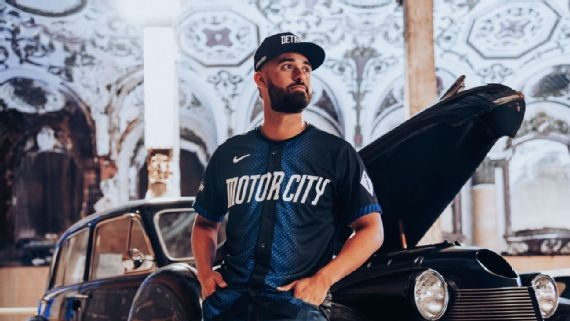
As our TS24 data indicates, concert merch is immensely popular. And this past weekend, my Detroit Tigers unveiled their new “City Connect” uniforms. This is a program that has impacted the entire league – special uniforms that reflect their city or region’s vibe. For an original MLB team like the Tigers, this Nike program is particularly brilliant. It freshens up team brands while selling tons of branded merchandise.
Don’t get me wrong – the old English “D” is one of the great insignias in all of sports. But sometimes, change can be good. For the Tigers, their electric blue “City Connect” uniforms look pretty cool. Anecdotally, I know several people who have already purchased some of this stuff – jerseys, hats, etc. Obviously, this initiative is about giving all 30 MLB teams a needed facelift, while jumpstarting merch sales.
Why couldn’t radio do the same thing? But instead of putting out yet another tired version of the same merch, enlist the help of fashion/design students at a local college or university to do it for you. And then move the voting onto the station website and mobile app. Rather than the same old clickbait, letting a merch facelift do the heavy lifting is something to consider, especially during the warm weather months.
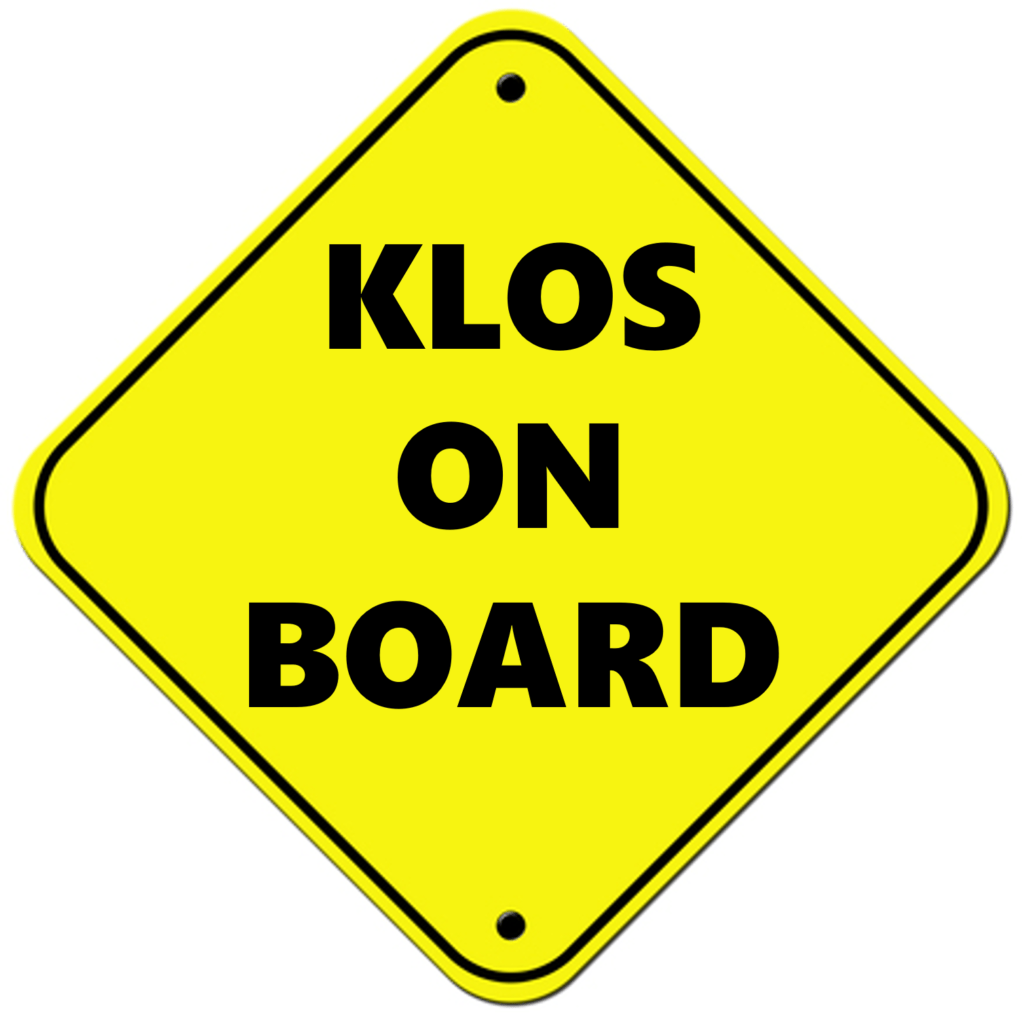 Heritage stations with strong logos but perhaps merch that hasn’t evolved a whole lot might want to think about “throwback” versions of their current logoware. Or classic/current versions, with the “classic” logo on the back and the current logo on the front.
Heritage stations with strong logos but perhaps merch that hasn’t evolved a whole lot might want to think about “throwback” versions of their current logoware. Or classic/current versions, with the “classic” logo on the back and the current logo on the front.
Or work with an area venue to create a station VIP section of your own. You can make this as big as you like, providing snacks, T-shirts, and meet & greets when available. Back in the day, we had “RIFF Rows” at area venues, an opportunity to create your own branded gold seats.
The concert and sports worlds are engaged in entertainment thought leadership, and consumers are signaling us they’re all in.
For radio heading into the summer, this might be a good time to get on board.
- The New Pope Was Selected Faster Than Most Radio Organizations Hire New CEOs - May 12, 2025
- What If Radio Tried Something Right Out Of Left Field? - May 9, 2025
- Why Radio PDs Are A Lot Like NBA Coaches - May 8, 2025




Hi Fred:
Interesting read and I must say that I loved listening in to WWOZ in NOLA as they broadcast live from the recent Jazz Fest. So great to hear “on the ground” commentary and live music from a place far from where I was listening in Maine. Hearing others express the vibe of the music and people who were in attendance and the sense of community…..that is what radio does so well when it wants to…..Sense of Place, Sense of Community and a informed guidance from friendly voices….. Alas…….. So wish this was more radio’s intent these days.